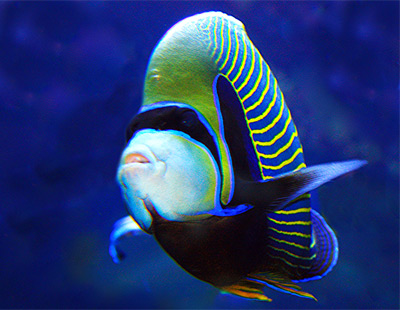Fish wounds and injuries can result from a variety of different influences, with tankmate aggression being among the more commonplace. Unfortunately, hobbyists don’t always recognize this problem right away when it manifests itself.
Tankmate aggression
This is a potential issue in any marine aquarium that houses more than one fish. In the most serious instances, where the aquarist severely underestimates the ability of one fish to injure another, aggression actually takes the form of predation. There are also cases of fish living peacefully side by side for years and suddenly beginning to fight.
Home aquarists are often in denial that any aggression is taking place because, with the exception of the most severe cases, it is very difficult to “catch them in the act.” Take, for example, a case of minor aggression where one fish is “tagging” another one (damaging a fin with a bite) at a rate of once or twice a day. What are the chances that an aquarist is going to see the aggressive act? It is over in a split second.
Additionally, while you are watching your fish for signs of problems, they are busy watching you and will often suspend any overtly aggressive behavior until you leave them alone again. Left unchecked, even this seemingly minor aggression problem will cause fish loss, as the damaged fins cannot regrow fast enough and the damage mounts.
If you see ripped and torn fins on one of your fish and the number of injuries is increasing, it is best to isolate that fish either by moving it to a new aquarium or by utilizing a tank divider. Some aquarists have experimented with moving the aggressor (if it can be identified) as a sort of “time out,” but this usually offers only a temporary solution to the problem.
Less frequently seen are instances of “displaced aggression.” In this case, a community of aquarium fish is cohabitating fine, with no aggression, but suddenly one fish turns on a tankmate with no warning and attacks it. More than just a “pecking order” or an “uneasy truce” that exists among animals in many aquariums, this is a serious problem with a rapid onset. What causes this displaced aggression? Not all fish will show this behavior, but its cause is stress imposed on one fish that is “diffused” by that fish then attacking another.
In public aquariums, the common stressor is external—e.g., a child pounding on the exhibit glass may suddenly cause an angelfish to turn and attack a damselfish. Moving tank decorations around or cleaning an aquarium may instigate displaced aggression. Red Sea fish of many species are well known to behave in this fashion, as are some temperate Australian species. In some cases, there is a cascade effect, with the attacked fish in turn attacking another and so on.



